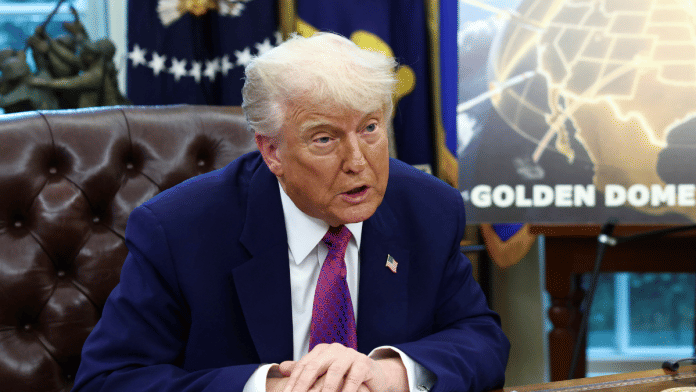New Delhi: US President Donald Trump formally unveiled the concept of his administration’s $175 billion ‘Golden Dome’ missile defence system, aimed at shielding America from aerial threats, including hypersonic weapons and space-launched projectiles.
“This is our national Iron Dome, but on a much grander scale,” Trump said Wednesday at a press briefing at the Oval Office, referencing Israel’s short-range missile defence system. “It will protect our homeland from threats no matter where they originate, even from space.”
First ordered via executive order in January 2025, the system’s design is said to counter threats from Russia and China, particularly emerging capabilities such as hypersonic glide vehicles and the Fractional Orbital Bombardment System (FOBS), systems that are considered too fast and complex for the existing ballistic missile defence (BMD) networks to neutralise.
At a press briefing in the White House, Trump said that the U.S. Space Force General Michael Guetlein would lead the programme. “Once fully constructed, the Golden Dome will be capable of intercepting missiles even if they are launched from other sides of the world, and even if they’re launched from space,” Trump said, adding that it is projected to be fully operational by the end of his current term in January, 2029.
The Elon Musk-led SpaceX is reportedly among the leading contenders for major contracts under the mega project.
Canada, he said, had expressed interest in joining. A statement from the office of Canadian Prime Minister Mark Carney confirmed ongoing talks with Washington to enhance the North American Aerospace Defense Command (NORAD), the binational U.S.-Canada aerospace command responsible for air defence across North America.
Trump also went on to compare Golden Dome to Ronald Reagan’s Strategic Defense Initiative (SDI), popularly dubbed ‘Star Wars’, which was shelved due to technological limitations in the 1980s. “Reagan wanted this, but we now have the technology to make it real,” Trump added.
Earlier this month, both Russia and China slammed the project as “destabilising”, warning that it could trigger a new arms race and turn space into a battlefield. The same month, the Congressional Budget Office estimated that the Golden Dome could cost as much as $831 billion over two decades.
Also Read: What is Akashteer & why it’s dubbed as ‘hell for Pakistan’s air adventures’
The concept
Although inspired by Israel’s Iron Dome, the Golden Dome is still in its conceptual phase, but with far greater scope and complexity. It aims to combine existing US missile defence systems with a new generation of space-based and terrestrial weapons.
The Golden Dome, according to US Secretary of Defense Pete Hegseth, will protect the homeland from “cruise missiles, ballistic missiles, hypersonic missiles, drones, whether they’re conventional or nuclear.”
At its core, the Golden Dome is designed as a multi-layered system that integrates low-Earth orbit satellites, radar sensors, kinetic interceptors and potentially even space-borne weapons like laser-based systems.
The space-based sensors to be integrated, such as the US Missile Defense Agency’s Hypersonic and Ballistic Tracking Space Sensor (HBTSS), are already under development and are expected to provide real-time data on incoming missile launches.
In terms of interception, the system would use a combination of existing and future assets, working in tandem to provide multiple opportunities to neutralise incoming aerial threats during different phases of flight.
An US official had confirmed to the Associated Press that the Pentagon is assessing three levels of capability—medium, high, and “extra high”—depending on how many interceptors and satellites are deployed.
For boost-phase (the missile’s earliest stage of flight) intercepts, space-based kill vehicles are envisioned to be employed. The missile shield will include space-based interceptors and sensors.
Meanwhile, for the mid-course phase, the US intends to expand its Ground-based Midcourse Defense (GMD) system at Fort Greely in Alaska, which is already operational with Next-Generation Interceptors (NGIs). The Aegis Ballistic Missile Defense system, deployed aboard Navy ships and Aegis Ashore sites, are also said to provide additional interception during the midcourse and terminal phases using SM-3 and SM-6 missiles.
On the ground, systems such as the Terminal High Altitude Area Defense (THAAD) and PAC-3 Patriot batteries will be used to intercept missiles in the terminal stage, when they re-enter the atmosphere or approach their targets.
Additionally, the Department of Defense is also reported to be investing in directed-energy weapons like high-powered lasers and microwave systems, which may offer an additional layer of interception in the future.
While still in its early stages, Golden Dome is currently backed by an initial $25 billion R&D budget within a broader $175 billion defence proposal submitted to the US Congress.
(Edited by Tony Rai)
Also Read: How upgraded L/70 guns, or ‘original Bofors’, became India’s frontline defence against Pakistan UAVs






